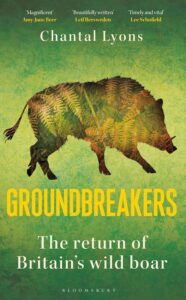Published today by Bloomsbury, Chantal Lyons’ ‘Groundbreakers: The Return of Britain’s Wild Boar’ traces how the webby tangle of the wild boar’s story extends into the human psyche, writes Kirsteen Bell.

Let me begin by confessing that, before reading this book, I had a vague idea to let our pigs loose into woodland on the croft to support the ecosystem as wild boar might. I was one of those that Lyons describes as trying to fit a pig into a boar-shaped ecological hole. However, it becomes apparent even in the introduction that our wee kune kune pigs cannot be compared to a tusked animal that draws its appearance from ‘bears, wolves, and hyenas’ and that could, ‘if it wants to, kill you’. I think about one of our pigs who liked to rub against the side of my boots as if he were a cat. The boar in Groundbreakers are a force: ‘a spark. Something new, something hot and bright with potential.’
In amongst the ‘webby tangle’ of Earth’s interconnected ecosystem, it is hubris now to think that humans can begin to understand the whole of which we are a part. Yet, ‘sometimes, in shining moments, single threads may be illuminated’, and Groundbreakers seeks to reveal one such thread. The webby tangle that is the wild boar’s story extends into the human psyche; Lyons tells the boars’ story whilst also disentangling the multiple polarised responses from people who find themselves sharing their landscape with this once lost species.
The fluctuating boar population at the centre of this book live in Forest of Dean, where Lyons herself now lives. She says, ‘when the Dean boar found themselves free again […] they flowed into the woods with the determination of roots finding cracks in stone.’
Lyons’ narrative progresses in the same determined manner, so much so that (and I don’t think she will mind the comparison) I imagine her like the boar, rooting and following every possible scent on her path. That trail leads her out of the forest, to Kent and Sussex, Galloway, further north to my own neck of the woods in Lochaber, and out to France and Catalonia. No stone left unturned, so to speak.
While the findings of this book stem from Lyons’ scientific background, she writes with a seasoning of opinion and an often-lovely turn of phrase that make for a spirited read. And while Lyons clearly loves the boar who have become the focus of her investigations, her personal motivations and assumptions are checked. Her apparent self-awareness is a strength of Groundbreakers: where there is a difference between the story she wants to hear and the story she is given, it becomes an opportunity to explore the relationship between the two and the implications for human perception and response to wild boar.
Boar may once have been a keystone species here, but it was in an entirely different landscape — physical and psychological. Absent now for centuries, they rarely appear in our folklore and stories and have failed to capture our collective imagination as wolves have done. In Lyons’ words: ‘We do not know the boar.’
In these pages the unpredictable character of wild boar shines. Their intelligence and behaviour are wonderfully captivating — and surprising. I walk and drive regularly through the Inverness-shire woodlands encompassed in Groundbreakers; and though I was aware of wild boar in the Highlands, reading about their lives is like discovering a secret, hopeful, garden.
That said, Lyons also makes me aware that I may not love that unpredictability if I were to meet a boar unexpectedly, especially where I walk so freely with no need of protective instinct. We have forgotten how to live with any real threat to our survival from other species in our shared ecosystems.
‘Boar are not predators like lynx or wolves. But they require an altogether different kind of living-with compared to what we are used to.’ Here then is the crux on which this book comfortably rests. We live in a landscape long purged of any meaningful risk to our lives from animals. With no place in living cultural memory, the unexpectedness of the boars’ presence is itself a central challenge to their existence here.
Despite the risks and the opposition, Lyons is unequivocal in her stance that the chance of any future — for all life — would be much improved by a cultural acceptance of wild boar. And she is convincing.
I am left eyeing the croft woods and speculating how my neighbours might take to living next to a boar. In truth, even our couple of pigs would be too much for these young trees — and also not enough. Humans managing an ecosystem on their own will never be enough. Neither would wild boar on their own, even if we had a croft the size of Forest of Dean. As one of Lyons’ interviewees says of their own land management, ‘We’re just gardening, really’. But perhaps allowing that we might live alongside the wild boar is enough of a beginning.
*
‘Groundbreakers: The Return of Britain’s Wild Boar’ is out now and available here (£19.00).
Kirsteen Bell lives and writes on a croft in Lochaber. She can also be found at Moniack Mhor, Scotland’s Creative Writing Centre, where she is Projects Manager and Highland Book Prize Co-ordinator. Follow her on Instagram and Twitter.